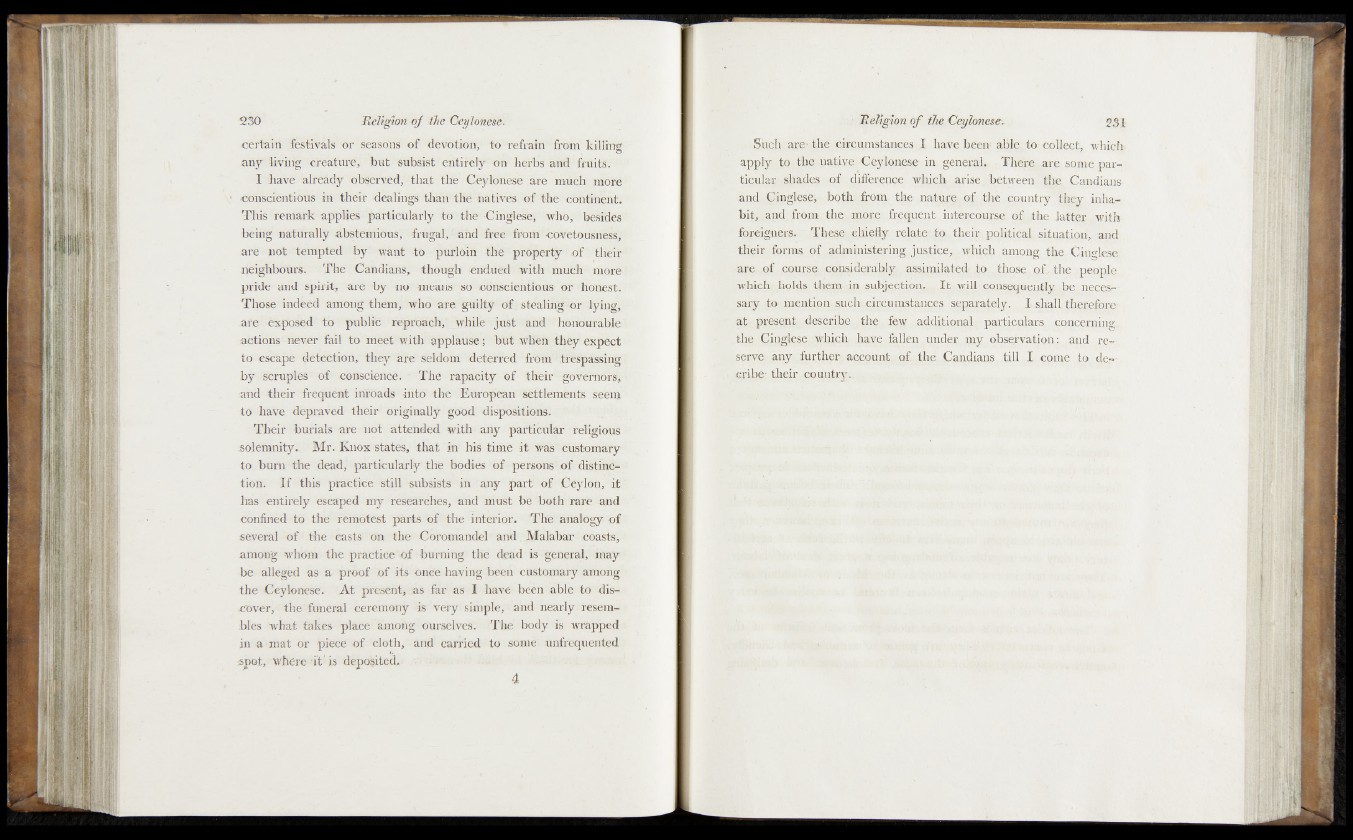
230 Religion’ o f the (Beyhnese*
certain festivals1 dr Seasons' of^d^^tidn,' "td^r-efrate^from killing
any 'Mvihjg dibatbi®^ b a t S-tfhsfet-*’ entiihly^eih -herbs a n d 1 fMitfev^
I have already ^ihfervedf^that the Geylbnese ,are much more
conscientious in*-their dealings tiianrtH§'bativesvWf-th'e^0^itinent.
This remark apphes-paiticularly to tire -Cmglese; 'who, besides
being" naturally abstemious, frugal,&and free57 fr-oih’bavetousness,
a re lioVdtempted "by want,;tb - purloin fsbe1" property1 ofe tlieifr*
neighbours. The Candians, though endued with muhh;’ more'
pride and spirits are by no -m'eens^so conscientious ji^Hhiiifesffe;
Those indee# amcSjg them, who are guilty- of, stea'Hh^^br lyingy
are- ekpbse#: t b ‘ public reproach,' while justI abd 'hohoUraMe.
aetions' never fail to meet w ith : applause; but when' they expect
to escape Refection, they are seldom deterred ' frijmb trespassing
by scruples5ss! xs^lsckjiice. The rapacity of their1
and their frequent inroads into the European leftlements seenj.
to have depraved their originally ^ObdlMisjjositionsi g
Their burials -areenot attended with - any paftietflSr'; religious
•solemnity . Mr. Knox states, th at in his time it was * ch'stomary
to burn the dead, particularly'the bodies o£^pet§dp* o f -
tiom I f this ptectefee?still -subsists in any part it
has eirtifely le a p e d my reli^iraies, and mult be'both-rife and
confined to the remotest parts of the interior. /The'analogy .of
several o f 7 the easts cm the Coromandel a n d , Malabar coasts,
among whbm the practice '<0f burning the dead is general, may
b e alleged as a proof of its %ncfe halving been customary among
the -Ceylonese. A t present, -as far as I have been able to discover,
the foneral ceremony is veiy- simple,‘-and nearly resembles
what takes place amoiigourselves. The body ds wrapped
in -a mat dr piece-of cloth, and earned to some unfrequented
spot, Where it is deposited, -
; Religion o f the Ceylonese. 231
>•. Suph f , ^ ; ^ e y g ^ g u h a v e b,een al^lgato- collect, which?
’apph|>4o.-fctb^^ajfeg^b^nesfiyviin-.. geneM *. v T h e r^ p ^ s q im e p a r-
tic p la p ^ a d c s wlaich^feise^hetwcpn the- Qandians
»amh ^ i n nk iCw. both^from- the .natym|i o£ Afe’^ o untr-J t^ey inha-
bifepqmdifEoiia^tlic^^ n^%J,i^ ijiji\ih..int/yi.0,111 se raf&ijfebft la tte r with
fi^rpjgpers.. ^ b e ^ e ^ i e f ly rrdafe^.tQ^thekffQlitica^ situation, and
itheir^orhi^ ci| „admihisl^rijQg,ii^t e c ^ vliich a ^ n n ^ .l^ k Ciiiglf^ws.
a r ^ o j ^ o u r s a c e ^ . d ^ ;y f e ^ assin^il|at^d^ifeir i ^ ^ es.M/thR people
w,Kich h o ld ^ , ^uhftf ctipn. I k wlljk c.on.scm i pnily^ - b^TVpr>es.-
isa;®A9: kentiQ.p ^uch’xh'cuimtances ^pMately,.* IdiallTherefi^e-
a t ,^ores.en.kdes6yheAfehpA .few ^additional« mrticulars, .aoncermug^
the Cinale^k ayhie k , .hqfeeJallen .undea.'my^ observation : and re ^
rsqr&iajj an^Mjfugt t i ^ ag^Qunt^l^jjbe Candians till I^ a am e to , $ej-
^ribej i^ e irico u ntry., .